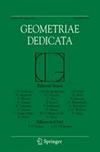局部对称空间的可变性:乘积情况
IF 0.5
4区 数学
Q3 MATHEMATICS
引用次数: 0
摘要
让\(X=X_1\times X_2\)是两个非紧密类型的一阶对称空间的乘积,并且\(\Gamma \)是\(G_1\times G_2\)中的一个无扭离散子群。我们证明\(\Gamma \backslash (X_1\times X_2)\)的谱与\(\Gamma \)在两个因子定义的两个方向上的渐近增长有关。我们得到,对于一大类 \(\Gamma \) 来说,\(L^2(\Gamma \backslash (G_1 \times G_2))\) 是有节制的。本文章由计算机程序翻译,如有差异,请以英文原文为准。

Temperedness of locally symmetric spaces: the product case
Let \(X=X_1\times X_2\) be a product of two rank one symmetric spaces of non-compact type and \(\Gamma \) a torsion-free discrete subgroup in \(G_1\times G_2\). We show that the spectrum of \(\Gamma \backslash (X_1\times X_2)\) is related to the asymptotic growth of \(\Gamma \) in the two directions defined by the two factors. We obtain that \(L^2(\Gamma \backslash (G_1 \times G_2))\) is tempered for a large class of \(\Gamma \).
求助全文
通过发布文献求助,成功后即可免费获取论文全文。
去求助
来源期刊

Geometriae Dedicata
数学-数学
CiteScore
0.90
自引率
0.00%
发文量
78
审稿时长
4-8 weeks
期刊介绍:
Geometriae Dedicata concentrates on geometry and its relationship to topology, group theory and the theory of dynamical systems.
Geometriae Dedicata aims to be a vehicle for excellent publications in geometry and related areas. Features of the journal will include:
A fast turn-around time for articles.
Special issues centered on specific topics.
All submitted papers should include some explanation of the context of the main results.
Geometriae Dedicata was founded in 1972 on the initiative of Hans Freudenthal in Utrecht, the Netherlands, who viewed geometry as a method rather than as a field. The present Board of Editors tries to continue in this spirit. The steady growth of the journal since its foundation is witness to the validity of the founder''s vision and to the success of the Editors'' mission.
 求助内容:
求助内容: 应助结果提醒方式:
应助结果提醒方式:


